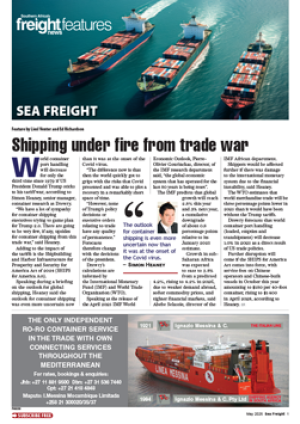RAY SMUTS
NO ONE can quite predict when his number is due to come up. Mining magnate Brett Kebble could not, as he slumped in his luxury car, mortally wounded from an assassin’s bullets, neither could a family namesake when his ship succumbed to enemy fire more than six decades earlier. His name was Guy Franklin Kebble and his short life reflects that of a man who was simply in the wrong place at the wrong time. Kebble’s remarkable story emerged recently when an English relative directed enquiries to the John H Marsh Research Centre in Cape Town, one of the most comprehensive of its kind in the world. Peter Honiball, a second cousin of the late Brett, was seeking research assistance about a World War II whale catcher, ‘Cos 23’, the first vessel on which Sub Lt Guy Franklin Kebble was supposed to have served. However, no such vessel existed under that name as Sigurd Sivertsen of Sandefjord, Norway, was quick to point out after noting the Honiball enquiry on the JMMC website. ‘Cos 23’, responded 78-year-old Sivertsen, was actually the KosXXIII, one of about 80 Antarctic-based whale catchers owned by Hvalfangerselskapet Kosmos II A/S, Sandefjord. Sivertsen, who worked for the company for much of his life and is writing a book about its whalers and factory ships, notes that KosXXIII was built at a British yard in 1937. She was converted to an anti-submarine ship in South Africa, sailing for the Mediterranean from Durban under British command on February 19, 1941. Honiball relates that Kebble was known to his shipmates as ‘Jimmy – The One’. Fellow shipmate Bob Jackson of Durban recalls that ‘Jimmy’, who apart from being first officer was also the navigation officer, would on a clear night take his sextant and point out the important stars in the sky. At odds with his commanding officer over a personal matter, Sub Lt.Kebble requested a transfer when KosXXIII reached Alexandria and was posted to HMS Gloucester, a light cruiser, on April 8, 1941. The following month, May 25, he was reported missing when the 35-knot warship, known as the ‘Fighting G”, was sunk by aircraft of the Luftwaffe during the evacuation of Crete, taking 746 of the complement to a watery grave. Kos XXIII however lived to sail on but was scuttled by her British crew in Scuda Bay only two days after the foundering of the Gloucester, raised thereafter by the Germans who put her into service as sub-chaser UJ-2104 ‘Darvik’ of 21 U-Bootsjagdflotille. After suffering heavy damage by the allies on September 18, 1943, the former KosXXIII was again scuttled, this time by her German crew, in the Bay of Stampalia. Guy Franklin Kebble was born in Johannesburg on June 25, 1911, educated at Boksburg High School and underwent naval training at SATS General Botha in 1926-27, after which he was seconded to Elder Dempster Line. He left sea in 1933 to work on the mines in the then Transvaal. Interestingly, Kebble’s brother Ralph was the father of alleged tax evader Roger, who in turn fathered fellow tax evader Brett, whose brother Guy is a former Springbok rugby player. (A member of the Honiball family, Henry, also played Springbok rugby). Overseen by former banker, Peter du Toit, the John H Marsh Maritime Research Centre is a resource centre for those interested in South Africa’s maritime heritage or wish to make a career at sea. Housed at the Iziko South African Maritime Museum for the past ten years, it is due to return to the Waterfront in December. During his 20-year career as shipping editor of the Cape Argus, after which he founded the Travel & Trade Promotion Organisation, which was later to become the Now Media publishing house in Illovo, Johannesburg (of which FTW forms part), John Marsh put together an amazing collection, carefully annotated, including information on some 9 200 ships that visited South Africa between the 1920s and 1960s. It includes
18 000 to 19 000 photographs, most of which he took himself. Enquiries for photographs are received from all around the world daily. The e-mail address for the John H Marsh Maritime Research Centre is: marsh@iziko.org.za A maritime career centre run by the Research Centre is sponsored by freight recruitment company Lee Botti & Associates. Lee is the daughter of John H Marsh.
Behind every ship is a tale of human drama
15 Dec 2006 - by Staff reporter
0 Comments
FTW - 15 Dec 06
15 Dec 2006
15 Dec 2006
15 Dec 2006
15 Dec 2006
15 Dec 2006
15 Dec 2006
15 Dec 2006
15 Dec 2006
15 Dec 2006
15 Dec 2006
Border Beat
Featured Jobs
New
New
